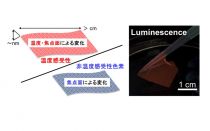Ultra-Thin Film Luminescence Sensor
2017-0223-05

- researcher's name
-
about researcher FUJIE, Toshinori Guest Researcher (retired)
- affiliation
-
- keyword
-
background
● Development of bio-sensing technology.
● Drawbacks in conventional bio-imaging technology : Seamless imaging from cells to tissues; Stable fixation of probes on the surface of biological tissue; Vibration control of monitored objects.
● Drawbacks in conventional bio-imaging technology : Seamless imaging from cells to tissues; Stable fixation of probes on the surface of biological tissue; Vibration control of monitored objects.
summary
● Luminescence sensor made from free-standing polymer nanosheets with the thickness of tens to hundreds of nanometers.
● Versatile fabrication by selecting sensor dyes (e.g.,temperature, oxygen concentration).
● Ratiometric sensing of biological information.
● Versatile fabrication by selecting sensor dyes (e.g.,temperature, oxygen concentration).
● Ratiometric sensing of biological information.
predominance
● To be stuck on biological tissues w/o glue fixation.
● High spatiotemporal resolution by ultra-thin structure.
● Wide-mapping range from a few cells to tissue size.
● High spatiotemporal resolution by ultra-thin structure.
● Wide-mapping range from a few cells to tissue size.
application/development
● Sticky sensor (High-spatiotemporal resolution, disposable).
● Sensors for extreme environment, surgical situation, etc.
● Sensors for extreme environment, surgical situation, etc.
material
collaborative researchers
佐藤 裕崇 (Nanyang Technological University) , TAKEOKA, Shinji Professor (Faculty of Science and Engineering School of Advanced Science and Engineering)
same researcher's seeds
-
 Electronic devices composed of polymer nanosheets
Electronic devices composed of polymer nanosheets -
 Nanosheet for detecting deformation and motion of biological tissue (soft materials)
Nanosheet for detecting deformation and motion of biological tissue (soft materials) -
 Flexible antenna coil for biological tissues
Flexible antenna coil for biological tissues
posted:
2017/02/23


